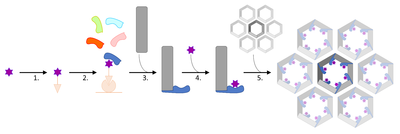Journal:Acta Cryst D:S2059798322010762
From Proteopedia
(Difference between revisions)

| Line 11: | Line 11: | ||
In principle this method is applicable even to large macromolecules, but in practice it is currently limited by the temperature factor gradient of the assembly, which is a feature of the host lattice design, and the occupancy of the target molecule. | In principle this method is applicable even to large macromolecules, but in practice it is currently limited by the temperature factor gradient of the assembly, which is a feature of the host lattice design, and the occupancy of the target molecule. | ||
| - | Ernst and colleagues<ref name='Ernst'>PMID: 31645583</ref> used the Endo-α-N-acetylgalactosaminidase from ''Bifidobacterium longum'' (EngBF) to generate the host lattice and fused the N-terminus of a Designed Ankyrin Repeat Protein (DARPin) to the C-terminus of EngBF by means of a rigid helical linker to obtain a unique incorporation of the target. The method was developed based on molecules with known three-dimensional structures. We now applied it to determine the structure of a novel leucinostatin derivative. Leucinostatins are water insoluble peptides with extraordinarily high cytotoxicity. To answer the question about the structure of this leucinostatin derivative under native-like conditions we selected two designed ankyrin repeat proteins and grafted the peptide binding sites on the previously developed host lattice molecule. The complexes were crystallized under the established conditions and the peptide structure was determined by difference Fourier analysis and refined at 2.05 Å and 2.36 Å resolution. The structure reveals a central alpha-helical moiety with elevated mobility at the termini. | + | Ernst and colleagues<ref name='Ernst'>PMID: 31645583</ref> used the Endo-α-N-acetylgalactosaminidase from [https://en.wikipedia.org/wiki/Bifidobacterium_longum''Bifidobacterium longum''] (EngBF) to generate the host lattice and fused the N-terminus of a [https://en.wikipedia.org/wiki/DARPin Designed Ankyrin Repeat Protein] (DARPin) to the C-terminus of EngBF by means of a rigid helical linker to obtain a unique incorporation of the target. The method was developed based on molecules with known three-dimensional structures. We now applied it to determine the structure of a novel leucinostatin derivative. Leucinostatins are water insoluble peptides with extraordinarily high cytotoxicity. To answer the question about the structure of this leucinostatin derivative under native-like conditions we selected two designed ankyrin repeat proteins and grafted the peptide binding sites on the previously developed host lattice molecule. The complexes were crystallized under the established conditions and the peptide structure was determined by difference Fourier analysis and refined at 2.05 Å and 2.36 Å resolution. The structure reveals a central alpha-helical moiety with elevated mobility at the termini. |
<scene name='93/936709/Cv/21'>EngBF-DARPin fusion in complex with the target molecule</scene>. EngBF_L1_E4_v1 is shown as a tube and the target ZHAWOC6027 as ball-and-sticks, colored according to the B-factor. The N-terminus of the symmetry-related complex is shown in grey and the disulfide bridge that locks the DARPin C-terminus to the symmetry-related N-terminus is also depicted as ball-and-sticks. | <scene name='93/936709/Cv/21'>EngBF-DARPin fusion in complex with the target molecule</scene>. EngBF_L1_E4_v1 is shown as a tube and the target ZHAWOC6027 as ball-and-sticks, colored according to the B-factor. The N-terminus of the symmetry-related complex is shown in grey and the disulfide bridge that locks the DARPin C-terminus to the symmetry-related N-terminus is also depicted as ball-and-sticks. | ||
Revision as of 15:49, 20 November 2022
| |||||||||||
This page complements a publication in scientific journals and is one of the Proteopedia's Interactive 3D Complement pages. For aditional details please see I3DC.

